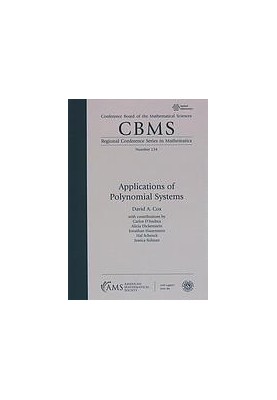Applications of polynomial systems
 Моментальное скачивание
Моментальное скачивание
после оплаты (24/7)
 Широкий выбор форматов
Широкий выбор форматов
(для всех устройств)
 Полная версия книги
Полная версия книги
(в т.ч. для Apple и Android)
Polynomials have been around for a long time. They play a prominent rolein many applications and are basic objects in commutative algebra and algebraicgeometry. In the 20th century, the foundations of algebraic geometry required alevel of abstraction that made these tools hard to use for many people interested inapplications. But with the advent of powerful algorithms, personal computers, andthe theory of sparse polynomials, we now have computational commutative algebraand computational algebraic geometry. Coupled with accessible introductory texts,recent years have witnessed a remarkable range of applications.The goal of this volume is to introduce some of these applications. The fivechapters are based on the NSF-CBMS Regional Research Conference Applicationsof Polynomial Systems held at Texas Christian University (TCU), June 4–8, 2018.The format of the conference, replicated in this book, is that each day David Coxgave two lectures on a topic, followed by a third lecture by an expert on the topic.The book is not a complete introduction to the topics covered. Many proofsare sketched or omitted, and the emphasis is on the examples. The hope is thatthe brief presentation provided here inspires you to learn more.The first two chapters set the background for the rest of the book. Chapter 1focuses on the rich history of elimination theory from the work of Newton andBézout in the 17th and 18th centuries through the decline of elimination theory inthe middle of the 20th century, followed by the emergence of symbolic computationin the latter part of the century. In the final section of the chapter, Carlos D’Andreabrings elimination theory into the 21st century.Chapter 2 begins with the tension between the perfect information neededfor symbolic computation and the messiness of the information coming from thereal world. The chapter explores linear algebra and homotopy continuation, twocommonly used methods for solving systems of polynomial equations numerically.This is where we meet our first substantial applications. Jonathan Hauensteinconcludes the chapter with a discussion of sampling in numerical algebraic geometry.The remaining chapters of the book focus on three substantial applications.Chapter 3 explores the geometry and algebra of geometric modeling, with someunexpected connections to toric varieties, algebraic statistics, and Rees algebras.At the end of the chapter, Hal Schenck surveys a variety of algebraic tools whichare used in geometric modeling.Chapter 4 is devoted to the geometry and combinatorics of rigidity theory.For bar-and-joint frameworks, basic objects include graphs and rigidity matrices,though polytopes and matroids also have an important role to play. A fun resultdue to Gross and Sullivant uses the rigidity matroid to study maximum likelihoodestimates of Gaussian graphical models coming from planar graphs. Jessica Sidmanends the chapter with a discussion of body-and-bar and body-and-cad frameworksand the study of non-generic frameworks via the Grassmann-Cayley algebra.Chapter 5 shifts the scene to chemical reaction networks, where the Law ofMass Action leads to a lovely combination of graph theory and dynamical systems.This framework includes examples from chemistry, biology, epidemiology, and pop-ulation genetics. Algebraic geometry enters the picture because the steady statesare defined by a polynomial system. Toric varieties also have a role to play by thepioneering work of Karin Gatermann. Alicia Dickenstein finishes the chapter withan exposition of the interesting things that can happen in biochemical reactionnetworks.Each chapter starts at a relatively elementary level, with more advanced topicsintroduced as needed. The algebraic geometry background can be found in the book[104]. In addition to the main applications presented in Chapters 3, 4, and 5, thetwin themes of toric varieties and algebraic statistics play a prominent role in thebook. Readers unfamiliar with this material should consult the expository papers[98] and [214].We hope you enjoy the book! We had fun writing it.
LF/93530155/R
Характеристики
- ФИО Автора
- Alicia Dickenstein
Carlos D’Andrea
David A. Cox (ed.)
Hal Schenck
Jessica Sidman (auth.)
Jonathan Hauenstein - Язык
- Английский
- Серия
- Regional conference series in mathematics no. 134.
- ISBN
- 9781470455897
- Дата выхода
- 2020















